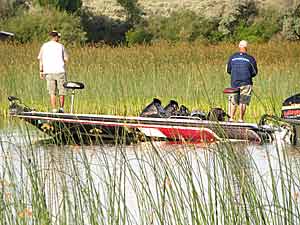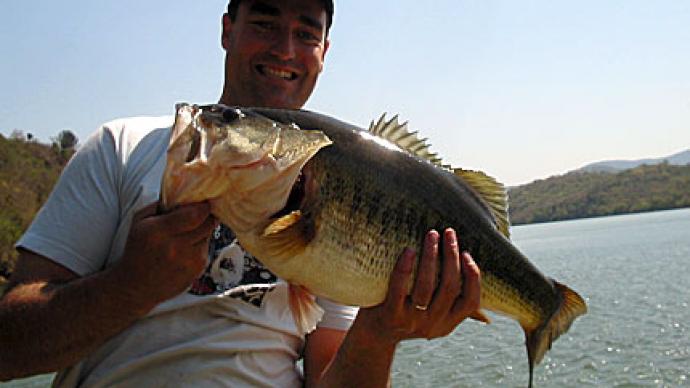
While filming a fishing show, I was amazed that my guest did not know how to pitch a jig. This person has most likely fished as many years as I have and is considered a pretty good angler by their peers.
Now, understand. I certainly don't claim to know everything there is to know about fishing, but pitching is such an essential part of the sport that I can't understand how anyone can get by without knowing how. At almost every lake I visit, there are just so many times that targets can only be reached by pitching. Even if you can get a lure into the water by other means, such as flipping, pitching almost always allows you to do so from a greater distance, which can be less disturbing to a bass.
Jig-and-pork combinations, Texas-rigged worms, spinnerbaits, and even crankbaits can be pitched back into boat stalls, under tree limbs and docks, just about any place you can see, and some you can't. I will caution you to use great care when pitching a lure with sharp hooks, but with a bit of practice, it really can be a great trick to add to your resume.
But here's the catch and why I decided to write about the subject. Practice.
How many anglers do you know who practice? No, I'm not giving you credit for practicing at the lake when you and your chosen partner search for bass. That is called fishing, not practicing.
The top athletes practice, and that's just about anyone good at their game. Football players, tennis, and golf enthusiasts, just about every game played with a ball calls for practice. Even hunters practice. No one expects to come home from the woods with supper or a trophy unless they practice shooting before they fire their gun. Think about it.
Some people buy a bass boat and, with no experience, go straight to the lake and practice driving. That's scary, but it's a thought for another column. But why do most "fisher(wo)men" reserve their practice time for when they are fishing?
You get to the lake determined to practice, but your partner sticks a fish, which makes you feel like you're missing out on the action or try a few times, but you're not very good at it. What happens, of course, is that you soon revert to what is easiest for you to accomplish.
It's human nature. To learn anything properly, you have to concentrate. To concentrate means you have to focus your attention on one thing. How do you accomplish that when nature surrounds you with its beauty or your buddy catches fish and you're not? Plain and simple, you don't. You may try and eventually succeed, but not without extra time and effort.
Pitching is so simple that sometimes people make it hard.
You need your favorite worm rod. It doesn't matter if it's long or short, but it does need to be stiff enough to pull a bass out of heavy cover once you get it on the end of your line.
You need a jig with the hook bent down so it doesn't snag "the Bosses" new carpet if you are in the den or just a worm weight tied on with a granny knot. Start with something heavy enough to let the weight do the work instead of your shoulder - say a half- or even 3/4-ounce.
Stand on a short stool or the coffee table if the wife (the Boss) is not home, so you have a foot or so between your feet and the floor. This is to replicate the difference between a boat's deck and the water's surface.
Knowing how to pitch does you no good if you can't hit what you are aiming at. Like pulling the trigger on a gun, any dummy can shoot a gun. It takes practice to hit something on purpose.
So, you need to have a target. Don't pick something too small and beat yourself up because you can't hit it. Start with a magazine or the jacket you left lying on the floor when you came to work. Anything will do, really, but do place your target about 10 or 15 feet from your perch. You can work on distance once you get the hang of it.
Now for the mechanics. Face your target with your rod tip pointed at about 10 o'clock. Hold your "lure" in your left hand loosely. It is essential to hold it no more than two or three inches in front of your reel and close to it. One of the biggest mistakes is having too much line.
At the same time, have the butt of your rod close to, but not touching your stomach.
Now, with both hands simultaneously, move them no more than six inches toward your target with a bit of a downward and upward motion at the end of this short swing. Like a half circle from about five- to 10-o'clock.
When you are about halfway in this arc, release your grip on the lure, but continue through with your reel hand to the 10 o'clock position. Of course, you need to release the button on your reel just as the lure starts to swing out and pull your line off the spool—nothing to it.
Well, at least you've started, and if you didn't break a lamp or vase, you can claim some success. Sure, the wife is right; you could be outside pestering the dog in the backyard instead of the cat in the house, but the cat is probably more interested than the dog, or your wife, for that matter.
Regardless, do it till you get it right. Practice. Practice until you can hit something as big as a gallon bucket at 20 feet without backlashing every time. Then, try it at the lake. Your buddy will be impressed, and so will the bass.
All the high-dollar gear and dozens of lures you own are tools. We use techniques to accomplish a desired end result by utilizing those tools. Pitching is one of the most essential techniques you will ever use while bass fishing. Don't go to the lake without at least knowing the fundamentals of how to utilize this skill.




